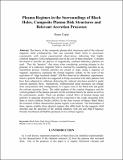| dc.contributor.author | Coppi, Bruno | |
| dc.date.accessioned | 2010-05-11T19:58:17Z | |
| dc.date.available | 2010-05-11T19:58:17Z | |
| dc.date.issued | 2010 | |
| dc.identifier.issn | 0094-243X | |
| dc.identifier.issn | 1551-7616 | |
| dc.identifier.uri | http://hdl.handle.net/1721.1/54760 | |
| dc.description.abstract | The theory of the composite plasma disk structures and of the relevant
magnetic field configurations that can surround black holes is presented,
consistently with recent experimental observations indicating that highly
coherent magnetic field configurations exist in the core of these structures. Concepts
developed to describe the physics of magnetically confined laboratory plasmas are
used. Thus the “paradox”, that arises when considering accreting plasmas in the
presence of a transverse magnetic field is resolved by considering accretion as an intermittent process whereby particles are carried in steps, along a sequence of
magnetic separatrices containing the formed magnetic islands, by the onset of the
equivalent of “edge localized modes” (ELMs) observed in laboratory experiments.
Inactive galactic black holes are suggested as being associated with older galaxies that
have been subjected to collisions destroying the coherent structures needed to guide
relevant accretion flows. Alternatively, tridimensional spiral structures can emerge
from axisymmetric disk configurations in a region close to the black hole and guide
the relevant accretion flows. The radial gradient of the rotation frequency and the
vertical gradient of the plasma pressure are the excitation factors for spirals as well as
for axisymmetric modes. These can produce vertical flows of thermal energy and
particles in opposing directions that can be connected to the winds emanating from
disks in Active Galactic Nuclei (AGNs). In the close vicinity of Binary Black Holes
the existence of three characteristic plasma regions is envisioned. The intermediate of
these regions exhibits three physical regimes that differ both for the magnetic field
structure and the spectrum of the emitted radiation, with jets and High Frequency
Periodic Oscillations (HFQPOs) produced in two of these regimes. | en |
| dc.description.sponsorship | United States Department of Energy | en |
| dc.language.iso | en_US | |
| dc.publisher | American Institute of Physics (AIP) | |
| dc.relation.isversionof | http://dx.doi.org/10.1063/1.3460115 | |
| dc.rights | Attribution-Noncommercial-Share Alike 3.0 Unported | en |
| dc.rights.uri | http://creativecommons.org/licenses/by-nc-sa/3.0/ | en |
| dc.source | Meg Rheault for Bruno Coppi | en |
| dc.subject | accretion processes | en |
| dc.subject | high energy plasmas | en |
| dc.subject | black holes | en |
| dc.title | Plasma Regimes in the Surroundings of Black Holes, Composite Plasma Disk Structures and Relevant Accretion Processes | en |
| dc.type | Article | en |
| dc.identifier.citation | Coppi, Bruno et al. “Plasma Regimes in the Surroundings of Black Holes, Composite Plasma Disk Structures and Relevant Accretion Processes.”
AIP Conference Proceedings, 1242 (2010): 11–22. | en |
| dc.contributor.department | Massachusetts Institute of Technology. Department of Physics | en_US |
| dc.contributor.approver | Coppi, Bruno | |
| dc.contributor.mitauthor | Coppi, Bruno | |
| dc.relation.journal | AIP Conference Proceedings | en |
| dc.eprint.version | Author's final manuscript | |
| dc.type.uri | http://purl.org/eprint/type/SubmittedJournalArticle | en |
| eprint.status | http://purl.org/eprint/status/PeerReviewed | en |
| dspace.orderedauthors | Coppi, Bruno | |
| dc.identifier.orcid | https://orcid.org/0000-0002-4920-8617 | |
| mit.license | OPEN_ACCESS_POLICY | en |
| mit.metadata.status | Complete | |
